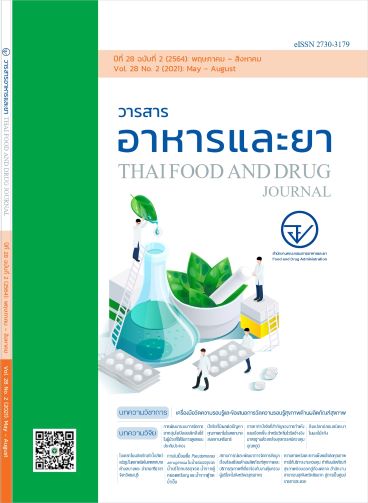การพัฒนาระบบการจัดการยากลุ่มโอปิออยส์เหลือใช้ในผู้ป่วยที่ได้รับการดูแลแบบ ประคับประคอง
Main Article Content
บทคัดย่อ
ความสำคัญ: ประเทศไทยมีผู้ป่วยที่ได้รับการดูแลแบบประคับประคอง (palliative care) และเข้าถึงยากลุ่มโอปิออยส์เฉลี่ยประมาณ 589 กิโลกรัมเบสต่อปี แต่ยาเหลือใช้จากการที่ผู้ป่วยเสียชีวิตหรือหยุดใช้ยาอาจเป็นความเสี่ยงที่ส่งผลกระทบต่อสุขภาพของผู้ที่นำไปใช้ต่อและอาจเกิดการรั่วไหลกลายเป็นอันตรายต่อสังคมหากมีการนำยาไปใช้ในทางที่ผิดหรือเสพติด
วัตถุประสงค์: เพื่อพัฒนาระบบการจัดการยากลุ่มโอปิออยส์เหลือใช้ในผู้ป่วยที่ได้รับการดูแลแบบประคับประคอง และศึกษาผลกระทบทางเศรษฐศาสตร์จากยากลุ่มโอปิออยส์เหลือใช้
วิธีการวิจัย: การศึกษานี้เป็นการวิจัยและพัฒนา ดำเนินการระหว่างวันที่ 1 มกราคม 2562 ถึง 31 ธันวาคม 2562 ที่โรงพยาบาลท่าวังผาและเครือข่ายหน่วยบริการสุขภาพระดับรองในเขตอำเภอท่าวังผา จังหวัดน่าน การวิจัยประกอบด้วย 4 ขั้นตอน ได้แก่ การศึกษาวิเคราะห์สภาพปัญหาและประเมินความต้องการที่จำเป็น โดยรวบรวมข้อมูลจากการสัมภาษณ์เชิงลึกจากผู้ที่เกี่ยวข้องและการทบทวนวรรณกรรมที่เกี่ยวข้อง การออกแบบและพัฒนารูปแบบระบบการจัดการยากลุ่มโอปิออยส์เหลือใช้ในผู้ป่วยที่ได้รับการดูแลแบบประคับประคอง การทดลองใช้ และการประเมินผลและปรับปรุงรูปแบบให้เหมาะสมยิ่งขึ้นและพร้อมที่จะนำไปใช้ต่อไป
ผลการศึกษา: พบว่า รูปแบบระบบการจัดการยากลุ่มโอปิออยส์เหลือใช้ในผู้ป่วยที่ได้รับการดูแลแบบประคับประคอง ที่ประกอบด้วยองค์ประกอบสำคัญคือ (1) การสร้างฐานข้อมูลผู้ป่วยที่ใช้ยากลุ่มโอปิออยส์ (2) การให้ความรู้ผู้ป่วยและญาติเรื่องการใช้ยาและการจัดการยากลุ่มโอปิออยส์เหลือใช้ (3) การสร้างเครือข่ายเพื่อร่วมติดตามการใช้ยาของผู้ป่วยในชุมชน (4) การสร้างระบบคืนยากลุ่มโอปิออยส์เหลือใช้เมื่อผู้ป่วยหยุดใช้ยาหรือเสียชีวิต และ (5) การกำหนดเป็นนโยบายสำคัญของคณะกรรมการเภสัชกรรมและการบำบัดของโรงพยาบาล ส่งผลต่อปริมาณและมูลค่ายากลุ่มโอปิออยส์เหลือใช้ และอัตราการคืนยาของผู้ป่วย โดยพบว่าหลังพัฒนารูปแบบปริมาณยากลุ่มโอปิออยส์เหลือใช้มีการคืนยาเพิ่มขึ้นจาก 235 เม็ด เป็น 1,213 เม็ด คิดเป็นมูลค่ารวมเพิ่มขึ้นจาก 4,930 เป็น 20,088 บาท อัตราการคืนยาของผู้ป่วยที่มียาเหลือใช้เพิ่มขึ้นจากร้อยละ 31.6 เป็นร้อยละ 100
สรุป: สรุปผลการวิจัยได้ว่า รูปแบบระบบการจัดการยากลุ่มโอปิออยส์เหลือใช้ในผู้ป่วยที่ได้รับการดูแลแบบประคับประคองสามารถทำให้อัตราการคืนยาเหลือใช้เพิ่มขึ้น ซึ่งเป็นการลดความเสี่ยงต่อการนำยาเหลือใช้ไปใช้ในทางที่ผิดและทำให้เกิดความปลอดภัยจากการให้บริการมากขึ้น
Article Details

อนุญาตภายใต้เงื่อนไข Creative Commons Attribution-NonCommercial-NoDerivatives 4.0 International License.
เอกสารอ้างอิง
2. World Health Organization. Palliative Care [Internet]. Geneva: WHO; 2018 [cited 2019 Oct 1]. Available from: https://www.who.int/news-room/fact-sheets/detail/palliative-care
3. Traue DC, Ross JR. Palliative care in non-malignant diseases. J R Soc Med 2005 Nov;98(11):503-6.
4. Strategy and Planning Division. Public Health Statistics A.D.2018. Nonthaburi: Ministry of Public Health; 2018.
5. มรกต จำรูญวรรธนะ. สถานการณ์และปัญหาการเข้าถึงยากลุ่มโอปิออยส์ กรณีศึกษา สำนักงานคณะกรรมการอาหารและยา. วารสารอาหารและยา 2563;27(2):13-27.
6. Welham GC, Mount JK, Gilson AM. Type and frequency of opioid pain medications returned for disposal. Drugs Real World Outcomes 2015;2:129-35. doi: 10.1007/s40801-015-019-4. PMID: 26317067; PMCID: PMC4543833.
7. Lewis ET, Cucciare MA, Trafton JA. What do patients do with unused opioid medications?. Clin J Pain 2014 Aug;30(8):654-62. doi: 10.1097/01.ajp.0000435447.96642.f4. PMID: 24281287.
8. Substance Abuse and Mental Health Services Administration. Opioid Overdose [Internet]. 2019 [cited 2020 Mar 3]. Available from: https://www.samhsa.gov/medication-assisted-treatment/treatment/opioid-overdose
9. Centers for Disease Control and Prevention. Vital signs: overdoses of prescription opioid pain relievers: United States, 1999–2008. MMWR 2011; 60(43):1487- 92.
10. Strategy and Planning Division, Office of the Permanent Secretary, Ministry of Public Health. Twenty-Year National Strategic Plan for Public Health (2017-2036) [Internet]. Bangkok: National Library of Thailand; 2018 [cited 2019 Jun 2]. Available from: http://bps.moph.go.th/new_bps/sites/default/files/EbookMOPH20yrsplan2017Eng.pdf
11. Narcotics Act, B.E. 2522. Royal Gazette No. 96, Part 63A special (Apr 27, 1979).
12. National Health Security Office. Annual report 2019. Bangkok: Sangchan; 2020.
13. Cruz M, Reddy A, Balankari V, Epner M, Frisbee-Hume S, Wu J, et al. The impact of an educational program on patient practices for safe use, storage, and disposal of opioids at a Comprehensive Cancer Center. Oncologist 2017 Jan;22(1):115-121.
14. Makki M, Hassali MA, Awaisu A, Hashmi F. The prevalence of unused medications in homes. Pharmacy (Basel) 2019 Jun;7(2):1-23.
15. Narcotics Control Division. Food and Drug Administration. Guideline for Medical Narcotic Disposal [Internet]. Nonthaburi: Thai FDA; 2017 [cited 2020 Feb 15]. Available from: http://www.fda.moph.go.th/sites/Narcotics/Eliminate/DP_s60.pdf
16. Chaiyakunapruk N, Nimpitakpong P, Dilokthornsakul P. The size and fiscal impact of medication over possession, solving problem by policy. Phitsanulok: Center of
Pharmaceutical Outcomes Research (CPOR), Faculty of Pharmaceutical Sciences Naresuan
University; 2012.
17. Dilokthornsakul P, Chaiyakunapruk N, Nimpitakpong P, Jeanpeerapong N, Jampachaisri K, Lee TA. Understanding medication oversupply and its predictors in the outpatient departments in Thailand. BMC Health Serv Res 2014 Sep 19;14:408.
18. McCabe SE, West BT, Boyd CJ. Leftover prescription opioids and nonmedical use among high school seniors: a multi-cohort national study. J Adolesc Health 2013 Apr;52(4):480-5.
19. Omae T, Yotani N, Sakashita A, Yoshiyuki K. Number of unused medications at the time of last admission: a prospective observational study in a single palliative care unit. Am J Hosp Palliat Care 2018 Dec;35(12):1498-504.
20. United States Government Accountability Office. Prescription opioids: patient options for safe and effective disposal of unused opioids [Internet]. MA Washington DC: Office; 2019 [cited 2019 Nov 23]. Available from: https://www.gao.gov/assets/710/701126.pdf
21. Bekker CL, Gardarsdottir H, Egberts ACG, Bouvy ML, van den Bemt BJF. Pharmacists' activities to reduce medication waste: an international survey. Pharmacy (Basel) 2018 Aug 29;6(3):1-14.
22. Suwannaprom P, Niamhun N, Champoonot P, Phosuya C, Chowwanapoonpohn H, Supakul S, et al. Items and value of household leftover medicines for chronic conditions at Sansai-Luang sub-district, Sansai district, Chiang Mai province. TPHSJ 2012;25:22–8.
23. Thavornwattanayong W, Jansuriyakul W, ChanpenS, Keesititsombun W, Srinuanrod K. Survey of left-over drug and drug use behavior among patients with chronic diseases in Nong Pak Long, Mueang, Nakhon Pathom. JHS 2012;126:1140–7.
24. Sadoyoo S, Jirapreeya N, Treesak C, Sangjam P. Leftover medications in patients with chronic diseases from home health care visits: a community study in Bangkok. Dialogue Pharm Health CarePract 2014;1:1–7.


